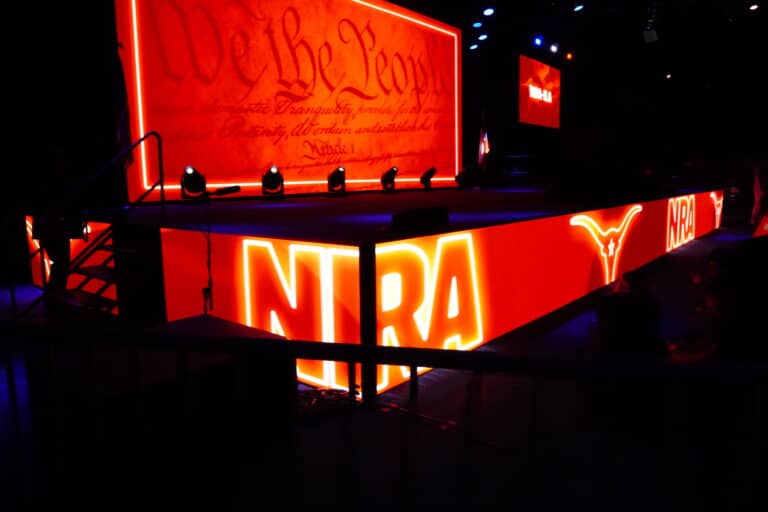The National Rifle Association is deeply troubled, but it still dominates American gun politics.
According to the latest round of internal documents obtained by The Reload, the NRA lost more than one million members over the last four years. That precipitous drop in membership has spearheaded a substantial decline in revenue over the same period. NRA revenues peaked in 2016 when the group brought in more than $366 million. Through November 2022, the group brought in just $186 million. As a result, it has been forced to operate on a greatly diminished budget and is now smaller than it has been since 2012 when internal documents show the group had 4 million members.
The reaction to this news has been mixed. Among gun-rights supporters, it has ranged from a sense of lamentation for what the group has become to outright indifference to its misfortune under the assumption that other groups are in a position to replace the NRA. Among gun-control advocates, there has been a mix of schadenfreude and a similar sense of confidence that their preferred groups stand to replace the NRA.
In this regard, both sides are seriously mistaken.
To hear gun-control advocates tell it, the Everytown for Gun Safety and Giffords’ of the world are now in a position to overtake the NRA in terms of finances and political influence.
“Now, in much of the country, Moms Demand [Action]’s influence has eclipsed that of its longtime adversary, the National Rifle Association,” wrote Washington Post reporter John Woodrow Cox earlier this year.
However, one look at the financials of each group tells a different story.
The NRA’s internal financial documents show that the membership arm of the group alone brought in over $210 million in revenue in 2021 through November. By comparison, 2021 IRS filings maintained by ProPublica show that Everytown for Gun Safety brought in just over $47 million in revenue throughout the entire year of 2021. Giffords, the second most prominent gun control group, brought in just over $20 million in 2021, split between its advocacy and litigation arms. The Brady Campaign, meanwhile, brought in roughly $3.2 million that year.
That means despite NRA revenues nearly halving between 2018 and 2021, they were still three times that of the three largest gun-control organizations combined.
In terms of political spending, the story is much of the same. To be sure, gun-control interests got a significant notch on their belt when they outspent the NRA for the first time ever in the 2018 midterm elections. That again led many to speculate that gun-control groups had gained parity with the NRA. But that has since looked more like a one-off fluke, given that the NRA retook the top spot in election spending in the 2020 Presidential election and held its ground during the most recent 2022 midterm elections.
The argument that alternative gun-rights organizations are poised to fill the NRA’s shoes is equally mistaken. The idea the NRA doesn’t matter anymore, and that x, y, or z group will simply pick up the slack has become common among pro-gun critics of the group. But here, again, the financials tell a different story.
According to IRS filings maintained by ProPublica, Gun Owners of America (GOA) brought in nearly $9.5 million in revenue in 2021. That’s up from about $5 million in 2018, just before the NRA’s scandals came to light, but still nowhere near the $200 million+ organization that the NRA remains. Likewise, the Second Amendment Foundation (SAF) brought in just over $10 million in 2021 between its core organization and its Citizens Committee for the Right to Keep and Bear Arms. Again, an increase from just over $6.2 million in 2018. But still a far smaller than the NRA. The Firearms Policy Coalition (FPC), a relative newcomer compared with the other gun-rights organizations, has seen the most growth from under $1 million in 2018 to over $6.4 million in 2021. But it falls well short of what even a battered NRA can still manage today.
These groups are boosting their influence, to be sure, and have been arguably more efficient with their dollars than the NRA in recent years, particularly on the legal front. But the growth of each of these organizations has yet to come close to offsetting the NRA’s revenue losses.
From 2018 to 2021, GOA, FPC, and SAF grew in revenue by a combined total of just under $14 million. Over the same timeframe, the NRA’s revenue decreased by approximately $130 million, meaning that the organization’s losses were not the other gun-rights groups’ gains. At least, not completely.
Furthermore, each remains a fraction of the size and offers nowhere near the breadth of services the NRA does for things like election spending, lobbying, safety and training, certifications, competitive shooting, law enforcement programs, and more. In fact, many of the non-political services the NRA offers are provided by affiliated non-profits that don’t even show up in the membership side’s filings.
The NRA is in trouble; there’s no question. But no other group on either side of the gun issue is in a position to fill the role currently played by the country’s oldest gun-rights organization. Most are lucky to raise 8 figures, and none can hope to raise 9 figures as the NRA commonly does. None have ever shown the ability to gather 60,000+ supporters together for an annual convention.
A very bad year for the NRA, as 2022 was, would still be an all-time record for any of the other gun groups out there.
The day when another group is able to supplant the NRA may be closer than ever before. But it hasn’t arrived yet and the NRA’s existing operations, warts and all, will continue to have significant implications for American gun politics.
Whether the group can pull out of its current downward financial spiral will ultimately determine for how long its influence remains above all else.







2 Responses
Left unsaid was the ~$60 Million spent on legal costs to fight off the LaPierre Debacle. So, 28% of the 2021 revenue was spent on legal BS. And THAT doesn’t include the $Millions spent to maintain LaPierre and minions in the manner to which they have become accustomed.
I haven’t and won’t contribute to NRA until LaPierre and his minions are gone.
I’m one of those that thinks there’s a lot of value in keeping our NRA – a gun org that’s been around since 1871 in the US needs to survive another hundred years and more. It’s bigger than LaPierre and if he had any decency or loyalty to the organization he would have read the room and gotten out of the way by now. The problem is LaPierre. The first job of any nonprofit is to keep the thieves out, and the NRA has failed at job #1. Like others, I support the NRA in my heart but won’t give money to it again until they reform the board, boot Wayne, and get some solid corporate governance in place. I don’t know what else to do other than hold money back. You get to feeling that the board elections are a sham – even if you can bullet vote your one guy onto the board of some 85 members, the board is designed to be ineffective and is packed with people beholden to Wayne. I’m not a whale of a donor, just a second gen lifetime NRA member who’s bummed about the state of affairs and eagerly awaiting Way e’s exit and hopefully a brighter future for the NRA.